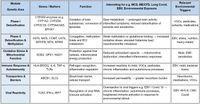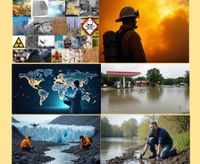GlobalBioSens
Biological Sensitivity Mapping: A New Era of Personalized Environmental Risk Navigation
It quickly became clear to me what name I wanted to give this “problem”. BioSens, because BioSens stands for the combination of biological sensitivity with intelligent sensor technology and people themselves (including myself, of course, with my MCS and CFS) become an early warning system for environmental stress. The name is intended to unite science, empathy and technology in one concept and transform individual perception into valuable collective resilience.
GlobalBioSens / BioSensEurope is my personal answer to an experience that many people share (whether ME/CFS, MCS, Mast Cell Disease, Long Covid, ADHD and many other chronic diseases), but that hardly anyone makes visible and usable. Based on my own years of experience with massive pre-reactions and with strategic clarity, I passionately develop concepts and resilience and scenario strategies. In May 2025, I had the great honor to speak at the Pracademic Emergency Management and Homeland Security Summit 2025 about my new innovative approaches in the context of deployment strategies and I would like to thank the Academic Board of Embry-Riddle University for this.
The increasing frequency and intensity of storms and extreme weather confronts us with new challenges every day. It is high time to rely on combined observation models that intelligently link human perception and technological sensors. Only through these integrative approaches can we protect human lives, preserve material assets and strengthen the resilience of our society in the long term.
The increase in locally extreme weather phenomena requires new approaches to risk detection and prevention. Traditional meteorological models reach their limits when it comes to highly dynamic, small-scale events. Combined observation models - especially those that combine biological early indicators with satellite-based remote sensing - offer promising potential for early hazard prevention and protection of critical infrastructures.
Our common goal should be the development of an innovative early warning system based on multimodal observation, i.e. by combining biological sensitivity, real-time atmospheric data and hydrological modeling, a new paradigm of disaster prevention can emerge. In times of increasing weather extremes, this should not be an additional luxury, but a necessary response to everyday reality.
Research is very important, but it must not remain in an ivory tower. What we need now are application-oriented models that can be integrated directly into everyday life, i.e. early warning systems that also use local sensitivity, digital tools that actively involve citizens and regional networks that can react immediately. In times of acute weather risks, we need to quickly bridge the gap between knowledge and action. This also means rapid pilot projects, pragmatic cooperation and courageous decisions, because nature does not wait for our funding cycles - it demands our responsibility now.
The magic word here is - transforming sensitivity into competence
Due to its fragmentation, I see a major weakness in current genetics-based diagnostics, which falls on our feet in this environmental and catastrophic text. Most providers supply SNP lists without functional correlation and compensation mechanisms, often with blanket recommendations that take neither the complex biochemistry nor the individual environmental impact into account. So I have taken my own path of analysis here. If one concentrates only on pharmacogenetics, environmental toxins, viral reactivity and oxidative stress often go unnoticed.. Standardized recommendations in reports along the lines of “take more B vitamins” instead of targeted, genetically tailored interventions are not always effective and effective. There is a lack of contextualization here, i.e. there is no connection to real symptoms, environmental factors or disease progression, as well as insufficient integration of environmental medicine, i.e. MCS, EBV, mold, VOCs, pesticides.
Genetic vulnerability in the context of climate change and environmental pollution
I use my personal sensitivity, resilience and genetic analysis not only for my own self-help or for friends and acquaintances, but above all as a strategic tool to strengthen the resilience of emergency services. This is urgently needed, especially at a time when the fire department, rescue services, emergency management and disaster control are increasingly exposed to extreme environmental conditions.
The increase in extreme weather events, rising levels of environmental toxins and climate-related changes pose not only ecological but also medical challenges. Technical measuring devices (e.g. VOC sensors, particulate matter measurement) often have a time delay, require threshold values or are not calibrated for all molecular stimuli. With appropriate sensitivity, the human body can certainly serve as an early biological indicator, especially in the case of complex mixed pollution or atmospheric fluctuations. People with genetic predispositions whose biological systems react sensitively to environmental stimuli are particularly affected. Fragmented gene profiles fail to recognize these systemic connections - with potentially serious consequences. Genetic variants do not act in isolation. Their combination influences central biological axes, which are additionally burdened by environmental factors
An example of fragmented analysis without further important context
You have MTHFR C677T → take folic acid = fragmented recommendation and not sufficiently targeted
Genetics is not destiny, but a navigation system - strive for holistic approaches
For example, you have ...
MTHFR C677T + A1298C → impaired methylation → inflammatory susceptibility + COMT Val158Met → prolonged catecholamine action at atmospheric pressure drop + GSTM1/GSTT1 deletion + HLA-DRB107:01* → increased immune activation to environmental antigens + TLR3 L412F overactivation → possible viral reactivation → chronic immune activation → medication as a trigger + TRPV1/TRPA1 → sensory perception of VOCs, pressure and pollen + SOD2 rs4880 → mitochondrial dysfunction → fatigue, brain fog, increased side effects + SLC22A5 (OCTN2) Carnitine transport defect Energy deficiency in heart and muscles → muscle burning, exhaustion + SLC25A37 Mitochondrial iron import Impaired heme synthesis → exhaustion, cellular stress + SLC30A8 / SLC39A8 Zinc transporters Involvement in immune, nervous and insulin function → increased neuronal sensitivity + ADRB1 Beta-adrenoceptor type 1 Overreaction to adrenaline → cardiac symptoms, pressure sensation
What we also need here in the future ...
- Systemic contextualization: not isolated SNPs, but truly functional networks
- Relevance to environmental medicine: much more focus on real triggers such as mold, VOCs, EBV
- Genetic weaknesses → targeted interventions e.g. glutathione, methylation ...
- Individualized prevention: early risk detection for MCS, CFS, long COVID, neuroinflammation and many more
Why our climate change is also increasing genetic stress
Increased histamine exposure due to environmental triggers: climate change as an amplifier of genetic weaknesses
Histamine is a biogenic amine that plays a central role in allergic reactions, inflammation and stress processes. It is normally broken down by enzymes such as DAO (diamine oxidase) and HNMT/COMT. However, genetic variants in these enzymes - such as MTHFR mutations, COMT-Val158Met or DAO-SNPs - lead to slower histamine processing. Climate change exacerbates this burden through a variety of new and more intense environmental triggers.
Extended pollen seasons and allergen exposure
Example: In Central Europe, the birch pollen season now starts up to 4 weeks earlier than 20 years ago.
Ragweed (ragweed) spreads due to mild winters - it produces extremely allergenic pollen with a high histamine release.
Grass pollen shows higher allergenicity due to CO₂ increase.
Consequence of genetic histamine degradation weakness:
- Chronic rhinitis, asthma, skin rashes, migrainesIncreased
- mast cell activation → neuroinflammation, irritable bowel syndrome
Mold growth due to moisture and extreme weather
Example: After heavy rain or flooding, indoor humidity rises → ideal conditions for molds such as Aspergillus, Penicillium, Cladosporium. These produce mycotoxins such as ochratoxin A, aflatoxin B1, which activate mast cells and release histamine.
Consequence of genetic weakness:
- Fatigue, brain fog, joint pain, irritable bowel symptoms
- Chronic inflammatory processes due to uncontrolled histamine release
VOCs due to heat stress in buildings
Volatile organic compounds (VOCs) are produced by the outgassing of materials when exposed to heat. Particularly affected are
Source, VOCs and Effects
Furniture, carpets → Formaldehyde, toluene → Respiratory irritation, mast cell activation
Wall paints, varnishes → Benzene, xylene → Neurotoxic, histamine-releasing
Plastic products → Phthalates, styrene → Hormonally active, immunomodulating
Example: In poorly ventilated homes, VOC concentrations rise to 3-5 times the normal value in summer. VOCs directly activate mast cells and increase the release of histamine.
Consequence of genetic COMT/MTHFR weakness:
- Sleep disorders, headaches, irritability, skin reactions
- Increased reaction to fragrances, cleaning agents, perfumes
Air quality, living space analysis, pollen monitoring and VOC measurements should also be an important part of prevention.
Heat, air pollution, VOCs, pollen, mold → increase the basic burden on our body.
This means that medications are already coming into contact with an already overstimulated, detoxification-weakened system.
Consequence: intolerances increase, even with “harmless” preparations.
Medication, environmental stimuli and stress act as multipliers on an already unstable balance. The solution lies not only in “avoidance”, but above all in understanding, stabilizing and individualizing.
From Experience to Concept Development
I began developing strategic concepts. Not just to describe my own perception, but to transform it. I explored my own genetics and identified individual markers. And yes, it’s a combination of many fascinating puzzle pieces – biological resonance, epigenetic dynamics, genetic predispositions and the ability to detect subtle changes in air, light and atmosphere.
Personalized environmental medicine in a spatial context, with high potential for early warning systems, disaster prevention and health planning, should not be a vision of the future, but can already be implemented in 2025.
GIS-supported integration of biological sensitivity - GIS-based risk analyses
- Mycotoxins (ochratoxin A, aflatoxin B1) → Moisture, mold formation → T-cell activation, neuroinflammation
- VOC metabolites (formaldehyde, benzene, toluene) → Air pollution, aerosols → Mast cell activation, respiratory distress
- Pesticides (glyphosate, paraquat, pyrethroids) → Soil erosion, agricultural land → Immunomodulation, autoimmune tendency
- Particulate matter (PM2.5) with oxidative components → Air turbulence, pressure drop → Oxidative stress, cytokine response
- Allergenic pollen proteins (e. g. birch, ragweed, grasses, Ambrosia, glass gray)
- Nanoparticles and metal ions → Atmospheric ionization → Cell stress, mitochondrial dysfunction
- Where is the burden particularly high?
- Who is (genetically) particularly vulnerable?
- When is an assignment a health risk?
- What are the spatial patterns of acute symptom exacerbations? This means that by analyzing symptom diaries in conjunction with geodata, hotspots can be identified, e.g. urban districts with high VOC exposure or rural regions with high pesticide use.
- How can protective measures be spatially optimized? In other words, where should air filters, protective clothing or breaks be given special consideration?
- How can GIS-based risk analysis be made available to emergency services or patients in real time? In other words, this is about the interface to the application: Mobile apps, warning systems or digital deployment planning could access the individual risk maps directly.
- How do exposure zones change due to weather, seasons or climate change? This allows dynamic risk developments to be identified - for example due to drops in air pressure, temperature changes or extreme weather conditions.
- Which environmental factors correlate most strongly with individual symptom manifestations? This question allows a targeted prioritization: Which exposures (e.g. VOCs, pollen, particulate matter) are particularly relevant for certain people?
- What early indicators can be derived from biological sensitivity before technical sensors take action? The role of humans as “biological early warning sensors” is thus concretized, e.g. in the case of rapid weather changes, air pollution or toxic stimuli.
- Which operational scenarios particularly benefit from individualized stress analysis? This is about practical applications such as forest fires, flood situations, urban air pollution, heat waves or building damage caused by mold.
- How can genetic and symptomatic sensitivity data be integrated into spatial models in a secure, ethical and anonymized way? (Data protection, ethics and technical feasibility - essential for the acceptance and scalability of the system). If it “fails” at the point of genetics, then no time should be lost and community building and symptom diaries should be cleverly combined, because this also creates a powerful system that not only collects data, but also promotes empowerment, prevention and resilience.


